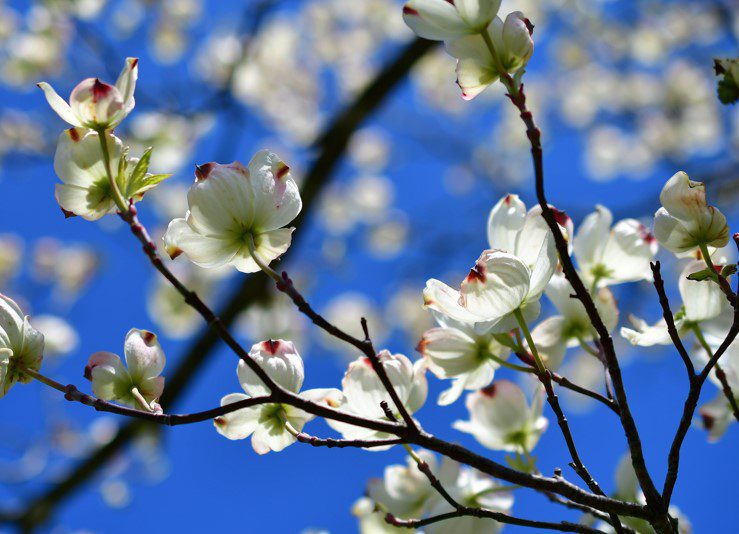Dogwood Tree
Many dogwood trees have the advantage of blooming in spring or summer and the deciduous varieties can give some wonderful autumn color.
As I was touring the landscape of a Southeastern college, I noticed that everywhere I looked was a native dogwood. I couldn’t help but think to myself, “This dogwood is for the birds.”
My thought was not too far off because this small tree feeds 28 species of birds, including quails and turkeys. Deer and squirrels also love the fruit, making this tree an all-star for those wanting a backyard wildlife habitat.
The native dogwood trees have a long history of cultivation going back as far as 1731. Botanically speaking, the native dogwood is known as Cornus florida. This Latin name says it all about our treasured little tree.
“Cornus” means rough or durable wood, and indeed in our country’s history, it has been in use in a variety of ways, from tool handles to wheel hubs.
You might think the “Florida” gives reference to it being native of that state, but in reality, it refers to the showy white flowers that are actually bracts or modified leaves.
Unfortunately, the common name “dogwood” does not have a very romantic origin.
It came from England where another species of Cornus was used to make a concoction to wash mangy dogs.
The species is, in fact, native to Florida and 32 other states, as far west as Texas and as far as north and Ontario, Canada.
Gardeners in western states relish their beauty as they also do their native species, the Cornus nuttallii or Pacific dogwood trees. The flowering dogwood is the tree of both Missouri and Virginia.
While we stand in awe at their picturesque springtime beauty, they can be enjoyed now as well. In some areas, they are as exquisite as hollies with bright red, oval-shaped fruits, or drupes.
In more northern locales, they exhibit exceptional red color in the fall that can be seen in a forest or landscape from hundreds of yards away.
Select a site with fertile, well-drained soil in partial sunlight and preferably with good air movement. Trees that face prolonged drought do need extra water to maintain their vigor.
I have planted bare-root dogwood trees and those nursery-grown in containers and have found that a container-grown plant is by far the easiest to get established.
While flowering dogwood trees and Pacific dogwoods are the showiest native species, the rough leaf dogwood Cornus drummondii is the wildlife champ, feeding 40 species of birds.
Nature-lovers should couple some of these at the edge of a forested lot. They are a great food source for local wildlife.
The dogwood’s trees small stature makes it ideal for today’s smaller urban landscapes. It makes an incredible partner with redbuds, azaleas, forsythias, and camellias.
An investigative search will reveal more varieties or named selections than you ever imagined, including a healthy supply of pink-flowered dogwoods.
So when someone tells you the dogwood tree is for the birds say, “Yes, I know. About 28 species to be exact!”
6 Care Tips For Dogwood Trees
1. Make a mulch bed over the roots. The larger the bed, the better. Actually, most of the feeding roots of trees are in the top 12 inches of soil, and mulch protects them from heat and drought.
A mulch also encourages the many minute microorganisms that are necessary for healthy roots and nutrient uptake.
A study by the National Park Service provided evidence that mulching sickly dogwoods on the highways in Washington, D.C., improved their vigor in about three years.
2. Fertilizer helps trees grow faster and makes them more vigorous, too. Though trees can be fertilized in spring, the preferred time is actually in autumn, just when the leaves begin to turn.
The current theory is that in fall fertilizer gets used to make new roots, and in the long run, good roots are the secret to good health.
In spring, the tree’s metabolism favors the growth of leaves and shoots. Softer, greener leaves are more susceptible to fungus attacks, which is why our native dogwoods are best fertilized in fall.
3. Give the tree sunlight and air movement. The leaves and twigs will dry faster, which will slow the fungus.
4. Watering during dry periods in the summer by running a hose on the ground around the roots (not with a sprinkler) will help.
A really good deep watering (with the hose on a drip at least overnight) will last for several weeks under mulch.
5. Pruning dead wood can be done, but wait until well into June before deciding what is dead. Sick plants are slow to leaf out.
In any event, prune dogwoods during dry weather, and be sure to disinfect the pruning shears with alcohol or diluted bleach.
How can you tell whether a branch with no leaves is dead? One way is if the bark is peeling. Another is that dead wood will snap off, while living wood usually has bend to it.
6. As with all stressed trees, small suckers or water shoots often appear on the trunk and remaining branches to compensate for the loss of leaves and twigs.
The old wisdom was to remove these to let the ends grow better. Currently, some experts say to leave these on, so their leaves can make food for the tree. However, if they begin to grow upright and tall.
I think it’s best to cut them back to about 8 inches, so they don’t become a new main shoot in the wrong place.
Don’t cut down a dogwood tree just because it’s infected (as was recommended some years ago).
Although some branches die, the trees may continue to bloom for a long time. I have trees that have been infected for about 15 years yet attain full flower. They’re still a joy to see.
























Comments are closed.